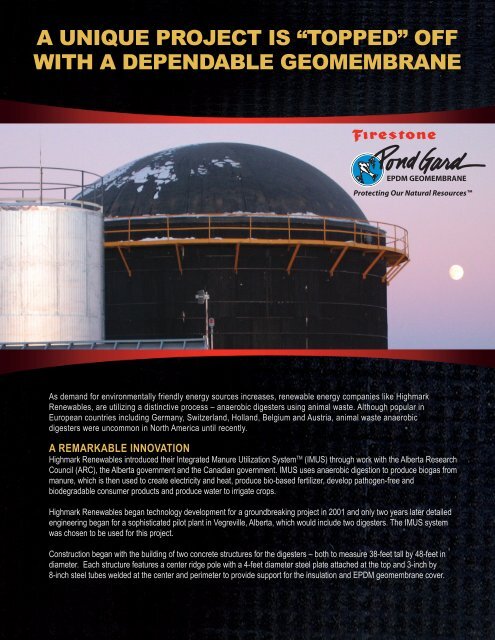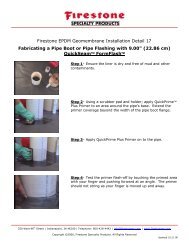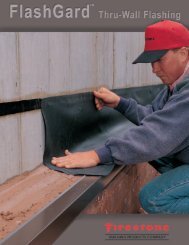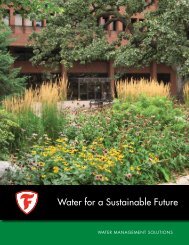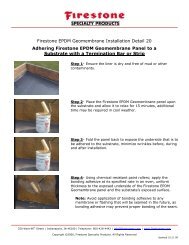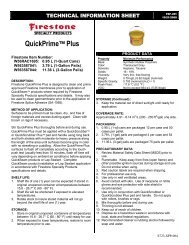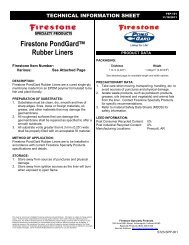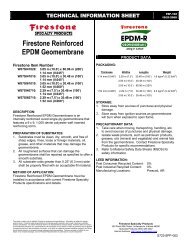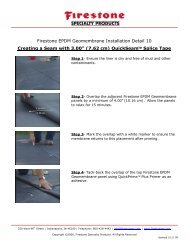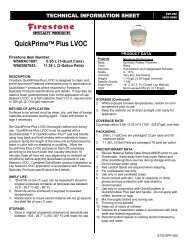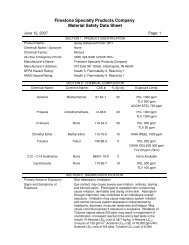Alberta Anaerobic Digesters - Firestone Specialty Products
Alberta Anaerobic Digesters - Firestone Specialty Products
Alberta Anaerobic Digesters - Firestone Specialty Products
- No tags were found...
You also want an ePaper? Increase the reach of your titles
YUMPU automatically turns print PDFs into web optimized ePapers that Google loves.
A UNIQUE PROJECT IS “TOPPED” OFFWITH A DEPENDABLE GEOMEMBRANEAs demand for environmentally friendly energy sources increases, renewable energy companies like HighmarkRenewables, are utilizing a distinctive process – anaerobic digesters using animal waste. Although popular inEuropean countries including Germany, Switzerland, Holland, Belgium and Austria, animal waste anaerobicdigesters were uncommon in North America until recently.A REMARKABLE INNOVATIONHighmark Renewables introduced their Integrated Manure Utilization System TM (IMUS) through work with the <strong>Alberta</strong> ResearchCouncil (ARC), the <strong>Alberta</strong> government and the Canadian government. IMUS uses anaerobic digestion to produce biogas frommanure, which is then used to create electricity and heat, produce bio-based fertilizer, develop pathogen-free andbiodegradable consumer products and produce water to irrigate crops.Highmark Renewables began technology development for a groundbreaking project in 2001 and only two years later detailedengineering began for a sophisticated pilot plant in Vegreville, <strong>Alberta</strong>, which would include two digesters. The IMUS systemwas chosen to be used for this project.Construction began with the building of two concrete structures for the digesters – both to measure 38-feet tall by 48-feet indiameter. Each structure features a center ridge pole with a 4-feet diameter steel plate attached at the top and 3-inch by8-inch steel tubes welded at the center and perimeter to provide support for the insulation and EPDM geomembrane cover.
A DEPENDABLE EPDM GEOMEMBRANE PROVIDES SOLUTIONSAs work on the project continued, contacts from both ARC and Highmark Renewables beganlooking for a reliable geomembrane to act as a lid on the digesters in order to house themethane gas. Earl Jenson, research engineer for ARC, was involved in specifying the materialto be used. He recommended PondGard EPDM Geomembrane from <strong>Firestone</strong> <strong>Specialty</strong><strong>Products</strong> Company.“I researched several options for this project and felt EPDM was the only compatible product,”Jenson said. “We chose 60-mil PondGard EPDM Geomembrane because of its outstandingelasticity and recoverable elongation, which are extremely important for ensuring the digestersfunction properly.”The two digesters were constructed and insulated inside before installation of the EPDMGeomembrane covers began and a representative from <strong>Firestone</strong> was on hand during theliner installation process. A crane lifted pie-shaped pieces of pre-cut 6-inch expandedpolystyrene insulation on top of the digesters to produce a thermal barrier. Additional holes wereadded to allow the methane to come up into the area above the insulation. A round hole wasalso cut directly over the 6-inch bleed-off pipe and the EPDM was deployed using the crane.The PondGard EPDM Geomembrane was then laid across the top of the digester, starting inthe center and unrolling from one side to another. Once it was unrolled, it was anchored to aperimeter utilizing a quarter-inch EPDM gasket above and below the membrane. Becausethe outside diameter of each digester was 48-feet, one piece of 50-feet by 50-feet PondGardEPDM Geomembrane fit almost perfectly.Next, 4-inch angle irons were set on top of the membrane, a hole was punched through to theconcrete, then a hole was drilled in the concrete and the process of installing concrete anchorbolts began. Once all of the 280 anchor bolts were installed, the bolts were torqued to apredetermined pressure on each digester. Finally, an industrial netting product was installedover the membrane to restrain it from over expanding beyond the digester’s hemisphere.This was one of the first anaerobic digesters, of this magnitude, done in North America withEPDM. The pilot plant has been successfully processing manure for more than two years.Mike Kotelko, general manager for Highmark Renewables, was pleased with the use ofPondGard EPDM Geomembrane. “I found PondGard EPDM Geomembrane to be very easyto install and it offers a wide range of operating flexibility, allowing us to use the product quiteeffectively,” Kotelko said. “PondGard was available in the size we required and there weredifferent thickness options for us to try out during the testing process, enabling us to find theright product for our application.”310 East 96th Street | Indianapolis, IN 46240800-428-4442 | Fax: 317-575-7002www.firestonesp.com | info@firestonesp.comQUICK FACTS:PROJECT:Two anaerobic digesters, both 38-feet tall and 48-feet in diameter, in Vegreville, <strong>Alberta</strong>. The digesters use the IMUS process,which uses anaerobic digestion to produce biogas from manure, which is then used to create electricity and heat, producebio-based fertilizer, develop pathogen-free and biodegradable consumer products and produce water to irrigate crops.CHALLENGE:SOLUTIONS:Needed a cover with flexibility and expandability to house methane gas for short periods of time at the top of the digesters.60-mil PondGard EPDM Geomembrane was chosen for its outstanding flexibility and because it can cycle through expansionand contraction better than competitive products. Two EPDM panels measuring 50-feet by 50-feet each were used (excessmaterial was trimmed). This was one of the first anaerobic digesters of this magnitude done in North America with EPDM.


